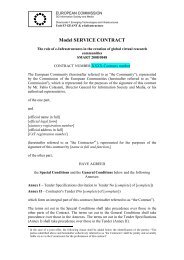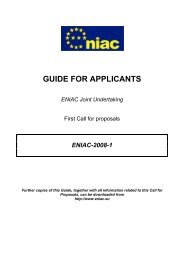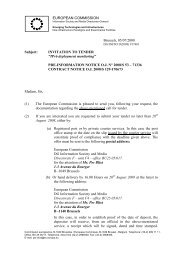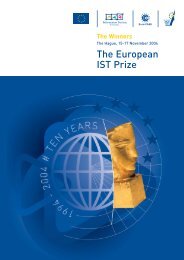Evaluator briefing
Evaluator briefing
Evaluator briefing
Create successful ePaper yourself
Turn your PDF publications into a flip-book with our unique Google optimized e-Paper software.
Information Society Technologies<br />
In the 6th Framework Programme<br />
<strong>Evaluator</strong> <strong>briefing</strong><br />
Evaluation IST Call 1<br />
24 April 2003
<strong>Evaluator</strong> <strong>briefing</strong><br />
•Roles Roles and definitions<br />
•The The evaluation process<br />
•<strong>Evaluator</strong> <strong>Evaluator</strong> responsibilities
Roles and definitions -Instruments<br />
Instruments - The different types of project funded in the<br />
Framework programme<br />
• Instruments<br />
The IST Priority funds five sorts of project :<br />
• Integrated project (IP)<br />
• Network of excellence (NOE)<br />
• Specific targeted research project (STREP)<br />
• Coordination action (CA)<br />
• Specific support action (SSA)
Roles and definitions -Instruments characteristics<br />
Instrument Purpose Primary<br />
deliverable<br />
Scale<br />
IP<br />
objectivedriven<br />
research<br />
knowledge<br />
med-high<br />
NoE<br />
tackle<br />
fragmentation<br />
structuring<br />
med-high<br />
169<br />
joint MS<br />
programmes<br />
knowledge and/or<br />
structuring<br />
high<br />
STRP<br />
research<br />
knowledge<br />
low-med<br />
CA<br />
coordination<br />
coordination<br />
low-med<br />
SSA<br />
support<br />
support<br />
low-med
Roles and definitions -Strategic Objective<br />
• Strategic objective (S.O) - One of the research areas<br />
mentioned in the IST call *<br />
• Strategic objective coordinator - The Commission<br />
official in overall charge of the evaluation of proposals in an<br />
S.O.<br />
*The call also includes a group of three FET (Future and Emerging<br />
Technologies) “Proactive initiatives”
Roles and definitions - Panels<br />
It is likely that each S.O. will receive more proposals than can<br />
be handled by a single group of evaluators, therefore:<br />
Panel - A group of evaluators responsible for the evaluation<br />
of a subset of proposals within a Strategic objective<br />
• Panel<br />
• Panel coordinator - The Commission official in overall<br />
charge of the evaluation of proposals in a panel<br />
The proposals sent to a Panel for evaluation may be defined:<br />
• by a technical sub-category within the Strategic objective<br />
• as a particular instrument or instruments within the S.O.<br />
• by a combination of the two
Roles and definitions - Proposal parts<br />
IST proposals are submitted in writing, in two parts:<br />
Part A (Forms):<br />
• A1 - Proposal summary (one form per proposal)<br />
• A2 - Details of participants (one form per participant)<br />
• A3 - Financial breakdown (one form per proposal)<br />
Part B<br />
• A text document (with supporting tables), written to a pre-<br />
determined structure, describing the proposed project<br />
• The structure of Part B varies per type of instrument
Roles and definitions - Evaluation criteria<br />
Each proposal is evaluated on a number of pre-determined<br />
criteria, which differ according to instrument type<br />
• Each criterion is scored 0-50<br />
• Each criterion has a “threshold” - a score which a proposal<br />
must reach to be considered for funding<br />
• A total score is also calculated for each proposal, by simple<br />
addition of its five/six criterion scores (no weighting scheme)<br />
• A threshold also applies to the total score<br />
• These criteria, and their threshold scores, are detailed on<br />
the forms used
Roles and definitions - Evaluation Criteria<br />
Evaluation criteria<br />
IP NOE STREP CA SSA<br />
Relevance X X X X X<br />
Potential impact X X X X X<br />
Scientific & tech excellence X X<br />
Degree of integration & the JPA<br />
X<br />
Quality of the coordination<br />
Quality of the support action<br />
X<br />
X<br />
Quality of the consortium X X X<br />
Excellence of participants<br />
X<br />
Quality of management X X X X<br />
Organisation and management<br />
X<br />
Mobilisation of resources X X X X
Roles and definitions - Scores<br />
Criteria are scored 0-5. 0<br />
Half marks may be given<br />
5 = Excellent<br />
4 = Very good<br />
3 = Good<br />
2 = Fair<br />
1 = Poor<br />
0 = The proposal fails to address the issue under examination<br />
or cannot be judged against the criterion due to missing or<br />
incomplete information
Roles and definitions - Horizontal Issues 1<br />
<strong>Evaluator</strong>s should also bear in mind “horizontal issues”<br />
• Are there gender issues related to the subject of the<br />
proposal?<br />
• Are ethical and safety aspects identified and dealt with?<br />
• Does it plan to spread awareness and knowledge, does it<br />
explore the societal implications of the work?<br />
• Are there synergies with education at all levels?<br />
• Is any third country participation justified, is it well<br />
integrated?
Roles and definitions - Horizontal Issues 2<br />
These horizontal issues are not scored, but may be taken into<br />
consideration in the score of relevant evaluation criteria. For<br />
example:<br />
• A proposal which ignored relevant gender issues, ethical or<br />
safety issues could get a lower score on criterion Scientific<br />
and technical excellence (or its equivalent)<br />
• A proposal which failed to spread awareness and<br />
knowledge, or ignored needed links to education, could get<br />
a lower score on criterion Impact<br />
• A proposal which failed to properly justify and integrate third<br />
country participation could get a lower score on criterion<br />
Quality of the consortium (or its equivalent)
Roles and definitions - Observers<br />
Independent external observers may monitor evaluations<br />
•Report to the Director General and the Programme<br />
Committee<br />
•Have full access to information and meetings<br />
•Are bound by the same confidentiality rules as evaluators<br />
•Do not influence evaluation result for any proposal !
Evaluation Process - Proposal assignment<br />
On arrival at the Commission<br />
• Proposal data (the content of the Part A forms) is entered in<br />
the database, and all the pages (Part A and Part B) are<br />
scanned<br />
• The assignment of the proposal to a Strategic objective is<br />
confirmed<br />
• If necessary, a cross-objective objective evaluation is planned
Evaluation Process - Eligibility-check<br />
The Strategic objective coordinator checks that each proposal<br />
• is complete with a Part A and a Part B<br />
• arrived before the deadline<br />
• is in scope for the call<br />
• is composed of an eligible consortium
Evaluation Process - Eligibility-check 2<br />
Completeness pre-check<br />
• If all of Part A or all of Part B are missing, the proposal will<br />
not go to evaluation<br />
• If only some information is missing, the proposal will go to<br />
evaluation. If the evaluators find they cannot score a<br />
particular criterion because of missing or incomplete<br />
information, they should score 0 on that criterion
Evaluation Process - Eligibility-check 3<br />
Arrival before deadline<br />
• Proposals arrived after the deadline (17.00 local Brussels<br />
time 24 April, 2003) will not go to evaluation<br />
• In cases of uncertainty, the proposal will go to evaluation. If<br />
it is subsequently found to have arrived late, its evaluation<br />
result will be declared null and void
Evaluation Process - Eligibility-check 4<br />
Proposal in scope of call<br />
• A proposal clearly out of scope of the call will not go to<br />
evaluation<br />
• In cases of uncertainty, the proposal will go to evaluation. If<br />
the evaluators find the centre of gravity of a proposal is in<br />
fact not within the call, they should score 1 on the criterion<br />
“Relevance”
Evaluation Process - Eligibility-check 5<br />
Consortium composition<br />
• Proposals not meeting eligible consortium requirements* do<br />
not go to evaluation<br />
* IP, NOE, STREP, CA - Three independent legal entities<br />
established in three different Member States or<br />
Associated States, of which at least two shall be<br />
established in a Member State or associated candidate<br />
country<br />
SSA - no specific requirement
Evaluation Process - Individual reading 1<br />
<strong>Evaluator</strong>s are assigned to each proposal<br />
• The Panel coordinator decides which evaluators will read<br />
each proposal, based on the evaluator’s skills and<br />
experience<br />
• Three evaluators are planned for each STREP, CA or SSA<br />
proposal, five evaluators for each IP or NOE proposal<br />
• Once their confidentiality declaration has been signed, each<br />
evaluator is given the proposals which he/she has been<br />
assigned to read
Evaluation Process - Individual reading 2<br />
The evaluators first carry out the “individual” readings<br />
• He/she evaluates proposals individually, without discussion<br />
with other evaluators who are also reading them<br />
• For each, he/she completes an Individual Assessment<br />
Report (IAR form) giving scores and comments on all criteria<br />
• The evaluator complete it on paper<br />
• The evaluator signs one the IAR form and hands it over to<br />
the Panel Co-ordinator<br />
ordinator
Evaluation Process - Individual reading 3<br />
Individual Assessment Report (IAR form)<br />
• Form differs according to instrument type<br />
• Form lists each of the five/six criteria applicable to the<br />
instrument<br />
• For each criterion it also gives supporting “sub-criteria”,<br />
which interpret the criterion but which are not themselves<br />
marked<br />
• Contains a box for overall remarks and total score<br />
(calculated by the arithmetic sum of all the criteria scores)
Evaluation Process - Individual reading 4<br />
Individual Assessment Report (IAR form)<br />
• (For IPs and NOEs) Includes a box for questions to be<br />
asked at a possible proposal hearing<br />
• Includes a box for comment on the “horizontal issues” if<br />
relevant (gender, ethics, links to education….)<br />
• Contains a flag box for “Ethical issues”
Evaluation Process - Consensus group 1<br />
After all the individual readings are complete for a particular<br />
proposal, the evaluators who read that proposal meet in a<br />
“Consensus group”, to agree scores and comments on all<br />
criteria for the proposal<br />
• The group consists of the five evaluators (IPs and NOEs) or<br />
three evaluators (STREPs, CAs or SSAs), with a<br />
Commission moderator<br />
• They continue in discussion until a consensus is reached,<br />
i.e. a decision to which all agree<br />
• In case of deadlock the moderator may bring in extra<br />
evaluators, or may finally accept a majority view
Evaluation Process - Consensus group 2<br />
One of the evaluators in the Consensus group is nominated<br />
as “Proposal rapporteur”. Or a specialist Proposal<br />
rapporteur may be used<br />
• The Proposal rapporteur is responsible for completing the<br />
various forms used for that proposal from now on<br />
• If a “non-evaluating” specialist rapporteur is used, he/she<br />
records the decisions but does not contribute to them *<br />
• The Proposal rapporteur completes the Consensus Report<br />
(CR) and Consensus Meeting Minute (CMM) forms<br />
* in exceptional cases, if suitably qualified, the specialist rapporteur may be asked<br />
by the moderator to contribute an opinion
Evaluation Process - Consensus group 3<br />
Consensus Report (CR form)<br />
• Form differs according to instrument type<br />
• Form lists each of the five/six criteria applicable to the instrument,<br />
without “sub-criteria”, plus space for overall remarks and total score<br />
• (For IPs and NOEs) Includes a box for questions to be asked at a<br />
proposal hearing - To be completed if the proposal is above all<br />
thresholds<br />
• Contains a flag box for “Ethical issues”<br />
• Can contain comment on horizontal issues under appropriate criteria<br />
ria<br />
• The Proposal rapporteur may complete the form directly on line using u<br />
the PESS, or may complete it on paper and have the data entered by<br />
support staff<br />
• A hard copy of the form is signed by all the members of the consensus<br />
group and the Commission moderator
Evaluation Process - Consensus group 4<br />
Consensus Meeting Minute (CMM form)<br />
• Standard form for all instrument types<br />
• “Free text” to show how the conclusions developed, and on<br />
what considerations they were finally based<br />
• A hard copy of the form is signed by the Proposal rapporteur<br />
and the Commission moderator
Evaluation Process - Consensus group 5<br />
If the “Ethical issues” box is flagged by even a single expert in i<br />
the Consensus group, the Proposal rapporteur also<br />
completes an Ethical Issues Report (EIR form)<br />
Ethical Issues Report (EIR form)<br />
• Standard form for all instrument types<br />
• <strong>Evaluator</strong>s identify the ethical issues and record any<br />
relevant comment<br />
• If the proposal passes all evaluation thresholds it will be sent<br />
for a separate ethical review<br />
• A hard copy of the form is signed by the Proposal rapporteur<br />
and the Commission moderator
Evaluation Process - Consensus group 6<br />
If the Individual Assessment Reports already show a strong<br />
convergence of views, the Proposal rapporteur may be<br />
asked to complete the forms and have them approved (and<br />
signed in hard copy by all members of the group) without a<br />
formal Consensus meeting
Evaluation Process - Panel meeting 1<br />
When the Consensus group discussions are completed for all<br />
the proposals in a panel, the evaluators assemble in a panel<br />
meeting with two objectives: finalise the evaluation of the<br />
proposals (ESR) and write the panel report<br />
• The panel meeting is chaired by the Panel coordinator, and<br />
a Panel rapporteur is appointed*<br />
• The panel reviews all the Consensus reports, so that the<br />
knowledge and experience of all is applied to each proposal<br />
• The panel may have a new opinion on the scores and<br />
comments for any proposal<br />
• The original CR forms are not changed, the new opinion is<br />
reflected in the Evaluation Summary Report of the proposal<br />
* either a member of the panel or a specialist rapporteur
Evaluation Process - Panel meeting 2<br />
Evaluation Summary Report (ESR)<br />
• Form differs according to instrument type<br />
• Form lists each of the five/six criteria applicable to the<br />
instrument, without “sub-criteria”<br />
• Contains a flag box for “Ethical issues”<br />
• Resolves any minority views. Focuses on the official<br />
evaluation criteria *<br />
• The Proposal rapporteur complete it on paper<br />
• The Evaluation Summary Reports are signed off as part of<br />
the panel report<br />
*Horizontal issues are dealt with in detail in the Consensus Report CR
Evaluation Process - Panel meeting 3<br />
For STREP, CA and SSA proposals the scores and comments<br />
agreed by the panel on the ESR are now final<br />
If the panel is handling only proposals of these types, it may<br />
directly begin preparing its Panel report
Evaluation Process - Panel meeting 4<br />
For IP and NOE proposals, the scores agreed by the panel<br />
now determine the next step<br />
• If one or more of the scores is below threshold, the scores<br />
and comments agreed by the panel on the ESR are now<br />
final<br />
• If all of the scores are above threshold, the proposal<br />
coordinator will be invited to a hearing on the proposal<br />
(<strong>Evaluator</strong>s involved in these hearings will be briefed in<br />
more detail on the hearing procedure at that time)<br />
After all the hearings have taken place, the panel meets to<br />
prepare its Panel report
Evaluation Process - Panel report<br />
To write its Panel report , the panel must first “prioritise“<br />
prioritise” ” all its<br />
above-threshold proposals…..<br />
The Commission prepares lists* of all the above-threshold<br />
proposals, ordered by overall score<br />
• The panel considers any proposals with tied scores, and<br />
imposes a priority between them<br />
…….then it writes a detailed report<br />
• Under the supervision of the Panel rapporteur, the panel<br />
writes its final Panel report in a predetermined format<br />
• This Panel report contains their prioritised lists<br />
*different instruments are listed separately
Evaluation Process - Strategic objective report<br />
When all the reports from all the panels within a Strategic<br />
objective are completed, representatives of each panel may<br />
meet to prepare an Strategic objective overview report<br />
This is because the Strategic objective overview may in some<br />
cases require the production of consolidated priority lists<br />
• The Commission consolidates the existing lists from the<br />
Panel reports<br />
• The representatives of the panels participating in the<br />
Strategic objective overview consider any proposals with<br />
tied scores, and impose a priority<br />
• They make other recommendations concerning overlapping<br />
proposal etc.
Evaluation Process - Sending of ESR<br />
The ESR sent to the proposal coordinator will follow certain<br />
content guidelines<br />
• If the proposal was ineligible, the ESR shows no scores,<br />
only an overall comment identifying the reason for<br />
ineligibility<br />
• If the proposal failed one or more thresholds, the ESR<br />
shows scores and comments on all criteria, and a total<br />
score. The overall comment only identifies the failed<br />
threshold(s)<br />
• If the proposal passed all thresholds, the ESR shows scores<br />
and comments on all criteria, and a total score. The overall<br />
comment must include any recommendations for negotiation
<strong>Evaluator</strong> responsibilities 1<br />
You give a fair and clear opinion on each proposal, and a<br />
ranking among them. You are:<br />
• Independent (you represent yourself, not your employer,<br />
not your country…..)<br />
• Honest (declare any conflict of interest you may encounter)<br />
• Accurate (use the official evaluation criteria only)<br />
• Consistent (apply the same standard of judgement to all<br />
proposals)<br />
• Discrete (individual names and opinions are confidential)<br />
• Incommunicado (external contacts on evaluation are not<br />
permitted during or after the evaluation)
<strong>Evaluator</strong> responsibilities 2<br />
Respect the rules regarding conflicts of interest<br />
• Declare your known conflicts of interest before the start of<br />
the evaluation<br />
• If you spot a new conflict of interest during the evaluation<br />
(for example during the reading of a proposal), alert your<br />
Panel coordinator immediately. He/she will take appropriate<br />
action<br />
• An evaluator with conflicts of interests will not participate in<br />
the evaluation of that or competing proposals
<strong>Evaluator</strong> responsibilities 3<br />
Respect the rules regarding confidentiality<br />
• You act independently, as experts<br />
• Your opinions are anonymous<br />
• Those of your fellow evaluators are equally anonymous<br />
Individual roles or opinions are NEVER revealed<br />
• Not by you, not by the Commission<br />
• Not now, not later!







